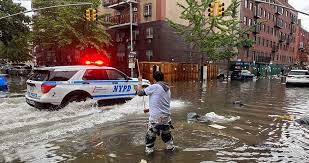Energy firms, hedge funds, and commodities traders are increasingly using financial products that allow them to wager on the weather in an effort to hedge against or benefit from the world’s increasingly harsh weather.
Average open interest in weather futures and options on the Chicago Mercantile Exchange was four times greater from January to September of last year and 12 times higher from January to September of this year compared to 2019.
The quantity of unresolved futures and option contracts is known as open interest. Additionally, in a year, trading volume has increased by four times.
In the late 1990s, weather derivatives were created. Due in part to American energy corporation Enron, the market grew and attracted speculators looking for assets removed from larger financial markets before contracting following the 2007–2008 financial crisis.
Now that huge utilities and other companies are utilizing contracts to protect themselves against the effects of climate change and concerns over the availability of energy, market participants are optimistic that growth will be more sustained this time.
Extreme weather events are anticipated to both increase in frequency and severity, according to Peter Keavey, global head of energy and environmental products at CME Group. “That has been the number one driver of this.”
The northern hemisphere summer of 2023 was the warmest ever recorded, according to the European Union Climate Change Service, a result of a combination of climate change and the El Nino weather event. The world has experienced terrible floods and wildfires this year as a result of the extreme weather that has been a recurring theme.
Through weather derivatives, purchasers can insure against the possibility that the weather will hurt their company’s bottom line. In contrast to insurance, where businesses must demonstrate that a loss has occurred, they make payouts based on indexes. These might keep tabs on the weather in New York or Paris.
An energy firm would often purchase a temperature-indexed contract to protect itself from the possibility that the winter heating season may be warm, which would result in lower natural gas sales. The contract’s value will increase and result in a payout at settlement if the temperature is higher than normal during that time.
Operators of ski resorts can take precautions against the possibility of insufficient snowfall, and organizers of music festivals can use rain protection. Usually, the other side of the deal is represented by major reinsurance companies or significant hedge funds, like the Citadel, run by American billionaire investor Kenneth Gryphon.
Nick Ernst, a seasoned industry professional hired by broker BGC Group in July to start a weather derivatives desk, said: “If you can measure it, and you can put a dollar amount on it, we can essentially have a product for you.”
According to Ernst, interest has been sparked by the conflict in Ukraine and the accompanying energy crisis as well as by U.S. and European rules stating that businesses must be aware of their exposure to climate change.
The Ukraine war, according to Statkraft, a business that produces renewable energy, revealed how flimsy energy supplies may be, said Matthew Hunt, head of the UK power desk. He claimed that he utilizes the “really useful” derivatives to protect himself against the possibility of there not being enough wind energy available to the grid.
Increasing Pains
Compared to its cousins that are related to commodities, the market is still small. Although market participants estimate 90% of the weather derivatives market is in over-the-counter agreements, the average open interest for CME weather futures and options contracts in September was around 170,000 contracts, compared to roughly 10 times that for crude oil.
Samuel Randalls, a professor at University College London who specializes in weather and climate, stated that extreme weather occurrences “tend to make good marketing for weather futures.” But he claimed that because they did not stop long-term developments that would render many enterprises unprofitable, they were only of limited benefit in combating climate change.
David Whitehead, co-chief executive of Speedwell Climate, which creates many of the meteorological indices that support the market, noted that education is a barrier. Since many individuals are unaware that these items exist, the expanding market for renewable energy has been beneficial.
“Everyone was concerned about the quantity of oil leaking from the earth. People now care about how much solar and wind energy there is, according to Whitehead.
But Randalls of UCL is dubious about the prospect of expansion.
“Unless businesses are convinced that this is a necessary activity – and that may be hard – the futures market will struggle to grow beyond a select group of companies and traders.”
Investors cannot trade weather indices like they might oil or bonds that support other futures markets, which is another potential restriction. According to BGC’s Ernst, this indicates that the market does not support pure speculative activity.
However, market players claim that institutions like hedge funds are once again becoming more involved. A player who is becoming more significant is Citadel.
According to Martin Malinow, founder and CEO of Parameter Climate, such businesses “see themselves as a risk warehouse like an insurance or reinsurance company.” “It is a sign of a more functional market, having players like Citadel in it that can play different roles.”


















